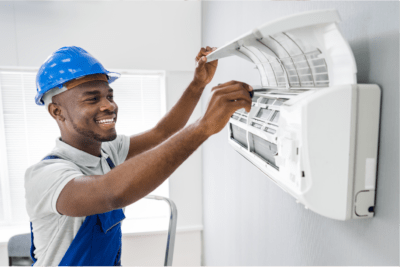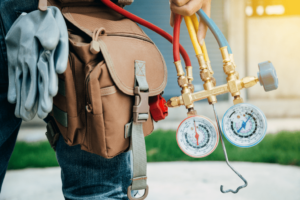One of the most economical and energy-efficient ways to both heat and cool your home is a high-efficiency heat pump. These easy-to-install and low-cost HVAC systems enable you to control the temperature inside your home all with one system. Like any HVAC system, it’s important to make sure they’re properly maintained to keep them working efficiently all year round.
How is a High-Efficiency Heat Pump Different?
What makes a heat pump the most efficient way to control the temperature in your home is its one-system use. Heat pumps work by pulling heat from outside the home and transferring it inside during the winter, using only a small amount of electricity to increase the temperature. In the summer, they do the reverse; they pull hot air from inside the home and transfer it outside, thereby cooling your home. In other words, heat pumps transfer heat instead of using energy to create it. Also, because heat pumps run on electricity, they’re often considered to be very safe because they don’t require gas or propane, eliminating the risk of a gas leak.
How Economical is an Energy-Efficient Heat Pump?
Due to the way it works, a high-efficiency heat pump means low energy costs for you and a smaller carbon footprint for the environment. On average, homes with an electric heating system save about 50% to 60% on their annual energy costs, depending on your existing heating system. With nearly two-thirds of home energy-use going towards heating and cooling in the average Canadian home, the savings can add up, making them one of the most economical heating options available today.
Proper Maintenance for High-Efficiency Heat Pumps
As with any HVAC system, it’s important to properly maintain your heat hump in order for it to continue working optimally. If a heat pump is poorly maintained, you can see an increase in energy use of between 10% and 25%. Thankfully, there are a few simple, but effective steps you can take to ensure proper maintenance of your high-efficiency heat pump:
- It’s important to clean or change the filters once a month or as needed. To do this, turn off the unit and remove the filter from the top of the unit. Use a vacuum or wash the filter under warm water; make sure the filter is completely dry before replacing it.
- In addition to filters, ensure the coils and fans are clean to ensure proper airflow through the system. Any resistance to airflow can decrease a heat pump’s performance and damage the compressor.
- The outdoor portion of the unit is just as important as the indoor one. Inspect it seasonally, especially between winter/spring and fall/winter. Make sure you clean the outdoor coils whenever they get dirty and remove any plant growth and debris from around the unit.
- In the winter, clear away any snow. The heat pump will use more energy melting the snow than actually heating your home. Use a soft-bristle brush or broom to clear away the snow to avoid damaging the unit.
- If ice forms on the outdoor unit in the winter, pour warm water over it to melt the ice. Avoid using any sharp objects or shovels that can damage the coils.
- To save energy, lower the thermostat at night or when you leave the house for more than four hours. Better yet, consider investing in a smart thermostat, which can save your settings and automatically adjust the temperature when needed.
- Having a professional technician inspect your heat pump every year will make sure it’s operating to its fullest potential.
Leasing an Energy-Efficient Heat Pump with Simply Green Home Services
Technician inspections and repairs can be expensive, but when you lease your equipment with Simply Green Home Services, all technician visits, as well the cost of replacement parts if needed, are covered. Plus, our free pre-inspection of your home will help make sure you get the right system for your family’s needs. To learn more about the benefits of leasing and to get started on upgrading to an energy-efficient heat pump, contact Simply Green Home Services today!




